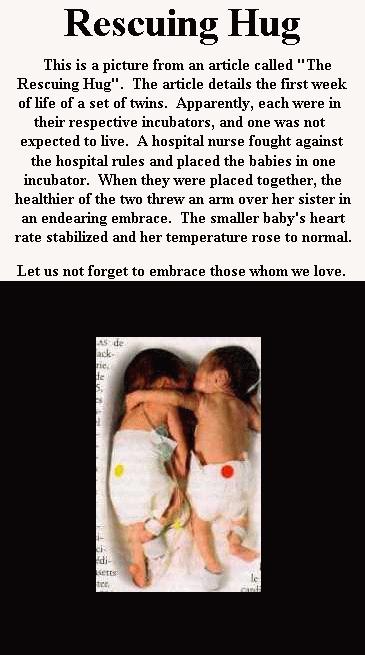Câlin sauveur
[1]
(Rescuing Hug)
par Nancy Sheehan
Reader's Digest © 1996
 Voici
l'émouvante photo provenant d'un article intitulé « Câlin sauveur ». Cet article
relate en détail la première semaine de bébés jumelles, Brielle et Kyrie, nées
le 17 octobre 1995. Prématurées de 12 semaines, elles avaient été placées dans
des incubateurs séparés. C'était une pratique courante au Medical Center of
Central Massachusetts in Worcester afin d'éviter les infections.
Voici
l'émouvante photo provenant d'un article intitulé « Câlin sauveur ». Cet article
relate en détail la première semaine de bébés jumelles, Brielle et Kyrie, nées
le 17 octobre 1995. Prématurées de 12 semaines, elles avaient été placées dans
des incubateurs séparés. C'était une pratique courante au Medical Center of
Central Massachusetts in Worcester afin d'éviter les infections.
Après quatre semaines, Kyrie s'en sortait bien, mais Brielle se mourait. Elle avait pleuré beaucoup et sa respiration était devenue difficile. Sa peau tournait du bleu au gris. Ayant tout essayé et ne sachant plus quoi faire, l'infirmière, Mme Gayle Kasparian, décida d'enfreindre le règlement et, sous le regard inquiet des parents, Heidi et Paul Jackson, elle plaça Kyrie dans le même incubateur que Brielle. Très rapidement, ses battements de cœur se stabilisèrent, elle se mit à respirer normalement et sa température s'éleva pour lui donner une couleur normale.
Peu de temps après, les jumelles purent quitter la pouponnière et rentrer à la maison.
* * *
[version originale de l'article]

A
Sister's Helping Hand
Who can measure the special bond of
twins?
by Nancy Sheehan
Reader's Digest - May 1996
Pages 155-156
Condensed from Worcester Telegram & Gazette
November 18, 1995
Heidi and Paul Jackson's twin girls, Brielle and Kyrie, were born October 17, 1995, 12 weeks ahead of their due date. Standard hospital practice is to place preemie twins in separate incubators to reduce the risk of infection. that was done for the Jackson girls in the neonatal intensive care unit at The Medical Center of Central Massachusetts in Worcester.
Kyrie, the larger sister at two pounds, three ounces, quickly began gaining weight and calmly sleeping her newborn days away. But Brielle, who weighed only two pounds at birth, couldn't keep up with her. She had breathing and heart-rate problems. The oxygen level in her blood was low, and her weight gain was slow.
Suddenly, on November 12, Brielle went into critical condition. She began gasping for breath, and her face and stick-thin arms and legs turned bluish-gray. Her heart rate was way up, and she got hiccups, a dangerous sign that her body was under stress. Her parents watched, terrified that she might die.
Nurse Gayle Kasparian tried everything she could think of to stabilize Brielle. She suctioned her breathing passages and turned up the oxygen flow to the incubator. Still Brielle squirmed and fussed as her oxygen intake plummeted and her heart rate soared.
Then Kasparian remembered something she had heard from a colleague. It was a procedure, common in parts of Europe but almost unheard of in this country, that called for double-bedding multiple-birth babies, especially preemies.
Kasparian's nurse manager, Susan Fitzback, was away at a conference, and the arrangement was unorthodox. But Kasparian decided to take the risk.
"Let me just try putting Brielle in with her sister to see if that helps," she said to the alarmed parents. "I don't know what else to do."
The Jacksons quickly gave the go-ahead, and Kasparian slipped the squirming baby into the incubator holding the sister she hadn't seen since birth. Then Kasparian and the Jacksons watched.
No sooner had the door of the incubator closed then Brielle snuggled up to Kyrie - and calmed right down. Within minutes Brielle's blood-oxygen readings were the best they had been since she was born. As she dozed, Kyrie wrapped her tiny arm around her smaller sibling.
By coincidence, the conference Fitzback was attending included a presentation on double-bedding. This is something I want to see happen at The Medical Center, she thought. But it might be hard making the change. On her return she was doing rounds when the nurse caring for the twins that morning said, "Sue, take a look in that isolette over there."
"I can't believe this," Fitzback said. "This is so beautiful."
"You mean, we can do it?" asked the nurse.
"Of course we can," Fitzback replied.
Today a handful of institutions around the country are adopting double-bedding, which seems to reduce the number of hospital days. The practice is growing quickly, even though the first scientific studies on it didn't begin until this past January.
But Heidi and Paul Jackson don't need any studies to know that double-bedding helped Brielle. She is thriving. In fact, now that the two girls are home, they still steep together - and still snuggle.
[1] Tiré de l'article de Nancy Sheehan publié dans le Reader's Digest de Mai 1996 et condensé à partir du Worcester Telegram & Gazette, du 18 novembre 1995 (page consultée le 19 janvier 2010). (Adaptation française F. Brooks)
